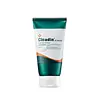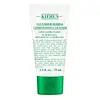What's inside
What's inside
 Key Ingredients
Key Ingredients

 Benefits
Benefits

 Concerns
Concerns

 Ingredients Side-by-side
Ingredients Side-by-side

Water
Skin ConditioningGlycerin
HumectantSodium Cocoyl Isethionate
CleansingGlyceryl Stearate
EmollientCetearyl Alcohol
EmollientCoco-Betaine
CleansingPropanediol
SolventCoconut Acid
CleansingSodium Methyl Cocoyl Taurate
CleansingHydroxypropyl Starch Phosphate
Sodium Isethionate
CleansingLauryl Hydroxysultaine
CleansingStearic Acid
CleansingSodium Chloride
MaskingSalicylic Acid
MaskingPotassium Benzoate
PreservativePalmitic Acid
EmollientLavandula Angustifolia Oil
MaskingSorbitol
HumectantButylene Glycol
HumectantCitrus Aurantium Bergamia Fruit Oil
Masking1,2-Hexanediol
Skin ConditioningDisodium EDTA
Hydroxyacetophenone
AntioxidantAnthemis Nobilis Flower Extract
MaskingArachidic Acid
CleansingPanthenol
Skin ConditioningHelianthus Annuus Seed Oil
EmollientCandida Bombicola/Glucose/Methyl Rapeseedate Ferment
AntimicrobialMyristic Acid
CleansingDipropylene Glycol
HumectantOleic Acid
EmollientBletilla Striata Root Extract
Skin ConditioningEchinacea Purpurea Extract
MoisturisingBacillus/Soybean Ferment Extract
Skin ConditioningPerilla Ocymoides Leaf Extract
TonicEthylhexylglycerin
Skin ConditioningCentella Asiatica Extract
CleansingEthoxydiglycol
HumectantAllantoin
Skin ConditioningSodium Hyaluronate
HumectantAsiaticoside
AntioxidantAsiatic Acid
Skin ConditioningMadecassic Acid
Skin ConditioningHydroxypropyltrimonium Hyaluronate
Sodium Acetylated Hyaluronate
HumectantHydrolyzed Hyaluronic Acid
HumectantHyaluronic Acid
HumectantSodium Hyaluronate Crosspolymer
HumectantPotassium Hyaluronate
Skin ConditioningMadecassoside
AntioxidantWater, Glycerin, Sodium Cocoyl Isethionate, Glyceryl Stearate, Cetearyl Alcohol, Coco-Betaine, Propanediol, Coconut Acid, Sodium Methyl Cocoyl Taurate, Hydroxypropyl Starch Phosphate, Sodium Isethionate, Lauryl Hydroxysultaine, Stearic Acid, Sodium Chloride, Salicylic Acid, Potassium Benzoate, Palmitic Acid, Lavandula Angustifolia Oil, Sorbitol, Butylene Glycol, Citrus Aurantium Bergamia Fruit Oil, 1,2-Hexanediol, Disodium EDTA, Hydroxyacetophenone, Anthemis Nobilis Flower Extract, Arachidic Acid, Panthenol, Helianthus Annuus Seed Oil, Candida Bombicola/Glucose/Methyl Rapeseedate Ferment, Myristic Acid, Dipropylene Glycol, Oleic Acid, Bletilla Striata Root Extract, Echinacea Purpurea Extract, Bacillus/Soybean Ferment Extract, Perilla Ocymoides Leaf Extract, Ethylhexylglycerin, Centella Asiatica Extract, Ethoxydiglycol, Allantoin, Sodium Hyaluronate, Asiaticoside, Asiatic Acid, Madecassic Acid, Hydroxypropyltrimonium Hyaluronate, Sodium Acetylated Hyaluronate, Hydrolyzed Hyaluronic Acid, Hyaluronic Acid, Sodium Hyaluronate Crosspolymer, Potassium Hyaluronate, Madecassoside
Water
Skin ConditioningPropylene Glycol
HumectantGlycerin
HumectantSodium Methyl Cocoyl Taurate
CleansingCoco-Betaine
CleansingSodium Cocoyl Isethionate
CleansingSodium Chloride
MaskingAcrylates/C10-30 Alkyl Acrylate Crosspolymer
Emulsion StabilisingPhenoxyethanol
PreservativePEG-100 Stearate
PPG-5-Ceteth-20
EmulsifyingGlyceryl Stearate
EmollientCoconut Acid
CleansingCaprylyl Glycol
EmollientPEG-55 Propylene Glycol Oleate
Styrene/Acrylates Copolymer
Salicylic Acid
MaskingChlorphenesin
AntimicrobialHydrogenated Coconut Acid
EmollientCucumis Sativus Fruit Extract
EmollientPolyquaternium-53
Coco-Glucoside
CleansingDisodium EDTA
Lavandula Hybrida Oil
EmollientSodium Isethionate
CleansingPEG-30 Dipolyhydroxystearate
EmulsifyingTrideceth-6
EmulsifyingCitrus Medica Peel Oil
Rosmarinus Officinalis Leaf Oil
MaskingBenzoic Acid
MaskingCitric Acid
BufferingSodium Hydroxide
BufferingWater, Propylene Glycol, Glycerin, Sodium Methyl Cocoyl Taurate, Coco-Betaine, Sodium Cocoyl Isethionate, Sodium Chloride, Acrylates/C10-30 Alkyl Acrylate Crosspolymer, Phenoxyethanol, PEG-100 Stearate, PPG-5-Ceteth-20, Glyceryl Stearate, Coconut Acid, Caprylyl Glycol, PEG-55 Propylene Glycol Oleate, Styrene/Acrylates Copolymer, Salicylic Acid, Chlorphenesin, Hydrogenated Coconut Acid, Cucumis Sativus Fruit Extract, Polyquaternium-53, Coco-Glucoside, Disodium EDTA, Lavandula Hybrida Oil, Sodium Isethionate, PEG-30 Dipolyhydroxystearate, Trideceth-6, Citrus Medica Peel Oil, Rosmarinus Officinalis Leaf Oil, Benzoic Acid, Citric Acid, Sodium Hydroxide
Ingredients Explained
These ingredients are found in both products.
Ingredients higher up in an ingredient list are typically present in a larger amount.
Coco-Betaine is the natural version of Cocamidopropyl Betaine. It is often derived from coconuts.
Coco-Betaine is a surfactant, meaning it helps remove dirt and oil from the skin.
Coconut Acid isn't fungal acne safe.
Disodium EDTA plays a role in making products more stable by aiding other preservatives.
It is a chelating agent, meaning it neutralizes metal ions that may be found in a product.
Disodium EDTA is a salt of edetic acid and is found to be safe in cosmetic ingredients.
Learn more about Disodium EDTAGlycerin is already naturally found in your skin. It helps moisturize and protect your skin.
A study from 2016 found glycerin to be more effective as a humectant than AHAs and hyaluronic acid.
As a humectant, it helps the skin stay hydrated by pulling moisture to your skin. The low molecular weight of glycerin allows it to pull moisture into the deeper layers of your skin.
Hydrated skin improves your skin barrier; Your skin barrier helps protect against irritants and bacteria.
Glycerin has also been found to have antimicrobial and antiviral properties. Due to these properties, glycerin is often used in wound and burn treatments.
In cosmetics, glycerin is usually derived from plants such as soybean or palm. However, it can also be sourced from animals, such as tallow or animal fat.
This ingredient is organic, colorless, odorless, and non-toxic.
Glycerin is the name for this ingredient in American English. British English uses Glycerol/Glycerine.
Learn more about GlycerinGlyceryl Stearate is a mix of glycerin and stearic acid.
It is used to stabilize the mixing of water and oil ingredients. By preventing these ingredients from separating, it can help elongate shelf life. It can also help thicken the product's texture.
As an emollient, it helps soften skin and supports barrier-replenishing ingredients.
In cosmetics, Glyceryl Stearate is often made from vegetable oils or synthetically produced.
This ingredient may not be fungal-acne safe
Fun fact: The human body also creates Glyceryl Stearate naturally.
Learn more about Glyceryl StearateSalicylic Acid (also known as beta hydroxy acid or BHA) is a well-known ingredient for treating skin that struggles with acne and clogged pores. It exfoliates both the skin's surface and deep within the pores to help clear out buildup, control oil, and reduce inflammation.
Unlike AHAs (alpha hydroxy acids), salicylic acid is oil-soluble. This allows it to penetrate into pores which makes it especially effective for treating blackheads and preventing future breakouts.
Salicylic acid is also known for its soothing properties. It has a similar structure to aspirin and can calm inflamed or irritated skin, making it a good option for acne-prone skin that is also sensitive.
Concentrations of 0.5-2% are recognized by the U.S. FDA as an over-the-counter topical acne product.
It can cause irritation and/or dryness if one's skin already has a compromised moisture barrier, so it's best to focus on repairing that before introducing this ingredient into your routine.
While salicylic acid does not increase sun sensitivity, it’s still important to wear sunscreen daily to protect your skin.
If you are looking for the ingredient called BHA or Butylated Hydroxyanisole, click here.
Learn more about Salicylic AcidChances are, you eat sodium chloride every day. Sodium Chloride is also known as table salt.
This ingredient has many purposes in skincare: thickener, emulsifier, and exfoliator.
You'll most likely find this ingredient in cleansers where it is used to create a gel-like texture. As an emulsifier, it also prevents ingredients from separating.
There is much debate on whether this ingredient is comedogenic. The short answer - comedogenic ratings don't tell the whole story. Learn more about comegodenic ratings here.
The concensus about this ingredient causing acne seems to be divided. Research is needed to understand if this ingredient does cause acne.
Scrubs may use salt as the primary exfoliating ingredient.
Learn more about Sodium ChlorideSodium cocoyl isethionate is a natural ingredient from coconut oil. It is an ultra gentle cleanser that gives a nice foam without drying the skin or impacting the skin barrier.
The amount of foam created depends on the amount of sodium cocoyl isethionate used in the product.
This ingredient also helps improve the spreadability of a product.
Learn more about Sodium Cocoyl IsethionateWe don't have a description for Sodium Isethionate yet.
This gentle cleansing and foaming ingredient is known for leaving a smooth feeling in skin and hair. It is made using coconut oil.
According to the manufacturer, it is soluble in water and has resistance to hard water, acid, and alkali.
Due to its coconut base, it may not be Malassezia folliculitis safe.
Learn more about Sodium Methyl Cocoyl TaurateWater. It's the most common cosmetic ingredient of all. You'll usually see it at the top of ingredient lists, meaning that it makes up the largest part of the product.
So why is it so popular? Water most often acts as a solvent - this means that it helps dissolve other ingredients into the formulation.
You'll also recognize water as that liquid we all need to stay alive. If you see this, drink a glass of water. Stay hydrated!
Learn more about Water